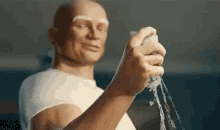This, very important, part is performed for each ARC task in order to extract as much information as possible. The more information that can be collected and combined, the easier it will be to identify patterns, repetitions and ultimately task logics.
Most of the Tasks from the ARC Dataset consist of around three examples and one task with an unknown output. Every example task consists of a two dimensional array with inputs (numbers 0-9) and a two dimensional array with outputs (also numbers 0-9).
These arrays are read in and converted to Grid objects, which have following attributes:
raw| the raw 2 dimensional array of numbers (normalized to start at 0,0)shape| the dimensions x,y of the grid e.g. (8,8)sum| the summed up value of all numbers inrawsize| the number of numbers which are not background, as for now which are not 0pixels| the raw grid as pixel objectscoord| the absolute x and y coordinatescolor| number between 0 and 9
colors| unique array of occurring numbersobjects| an array with all detected objects in the grid. (see Object Detection)
Detecting objects is a key part of the challenge, because most of the logics depend on transformation, collision, translation, counting etc. of objects. After some research and multiple iteration where it was tried to recursively find subobjects, it was decided to start simpler. It is achieved by clustering all numbers by color and neighbours with help of skimage's 2-connectivity. 1
2-connectivity
[ ] [ ] [ ]
\ | /
[ ]--[x]--[ ]
/ | \
[ ] [ ] [ ]
The drawback of this method is, that in reality objects can also be multicolored. Tests will show if they can be seen as multiple objects with the same behavior, which legitimates our simple approach, or not.
Not all exercises have something to do with objectness. Most of the other exercises which are not related to objectness have a color pattern which needs to be somehow predicted. Therefore the idea is to use sliding window technique to find repeated patterns. This can also be used to detect a subgrid's position in a parent grid. Findings have shown, that pattern recognition and object detection are strongly linked in relation to ARC tasks.
